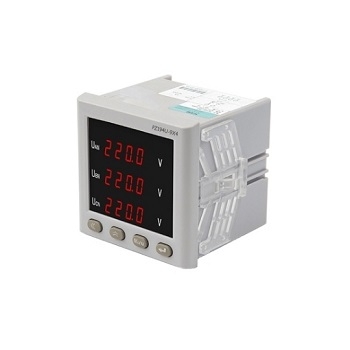A digital panel meter is an electronic instrument used to measure, display, and monitor various physical quantities or electrical signals. Unlike traditional analog instruments, digital panel meters use digital display technology to present measured values in digital form. Digital panel meters are widely used in a variety of applications because of their high accuracy, good readability, versatility, and ease of integration.
Principle of Operation
The working principle of a digital panel meter is based on converting analog physical signals into digital form, digitally processing them, and presenting them in the form of a digital display, enabling users to easily and accurately measure and monitor a variety of physical quantities. The working of a digital panel meter starts with one or more sensors or measuring elements that are used to detect, measure, and capture physical quantities such as temperature, voltage, current, pressure, etc.
The sensors convert these physical quantities into analog electrical signals. The received analog electrical signals are converted from continuous analog electrical signals to discrete digital values by an ADC. Once the signals have been converted to digital form, the digital processing unit inside the digital panel meter can perform a variety of operations, including unit conversions, calibration, averaging, filtering, and calculations.
Working Steps
Signal Input: The digital panel meter first receives electrical signals from sensors or measuring elements. These signals can be analog, such as voltage, current, and resistance values, or digital, such as counting signals.
Analog to Digital Conversion: Once the analog signal is received, the digital panel meter uses an analog-to-digital converter to convert the analog signal to a digital signal. The purpose of analog-to-digital conversion is to convert a continuous analog signal into a discrete digital value, usually expressed in binary form.
Digital Processing: The processing unit inside the digital panel meter receives the digital signal and can perform various calculations, unit conversions, and calibration operations. These operations ensure the accuracy and reliability of the measured values. Digital processing can also include smoothing, filtering, and calibrating the data to minimize measurement errors.
Digital Display: The final digital value is presented as a digital display on the meter's display. This is usually an LED (Light Emitting Diode), LCD (Liquid Crystal Display), or other digital display technology that presents the digital information in an easy-to-read format. The display can include both an integer portion and a decimal portion, depending on the accuracy and settings of the measured value.
User Interface: Digital panel meters are often equipped with a user interface, such as buttons, knobs, or a touch screen so that the user can make settings, switch functions, or view different measurement parameters. The user interface allows the operator to interact with the digital panel meter and make adjustments as needed.
Power Supply: A digital panel meter typically requires a power supply to provide energy to its internal circuitry and display. Power supply requirements can vary depending on the model and specifications of the digital panel meter, and typically use either an AC power supply or a DC power supply.
Digital panel meters perform measurement and display functions by converting analog signals to digital signals, performing digital processing, and then displaying the measured values in digital form. This digitization provides highly accurate and repeatable measurements, reduces human error, and accommodates the need for accuracy and reliability in modern industrial and scientific applications. sisco store provides high-quality digital panel meters, and many kinds of digital panel meters for various purposes have one is what you need, if interested, welcome to visit us.

